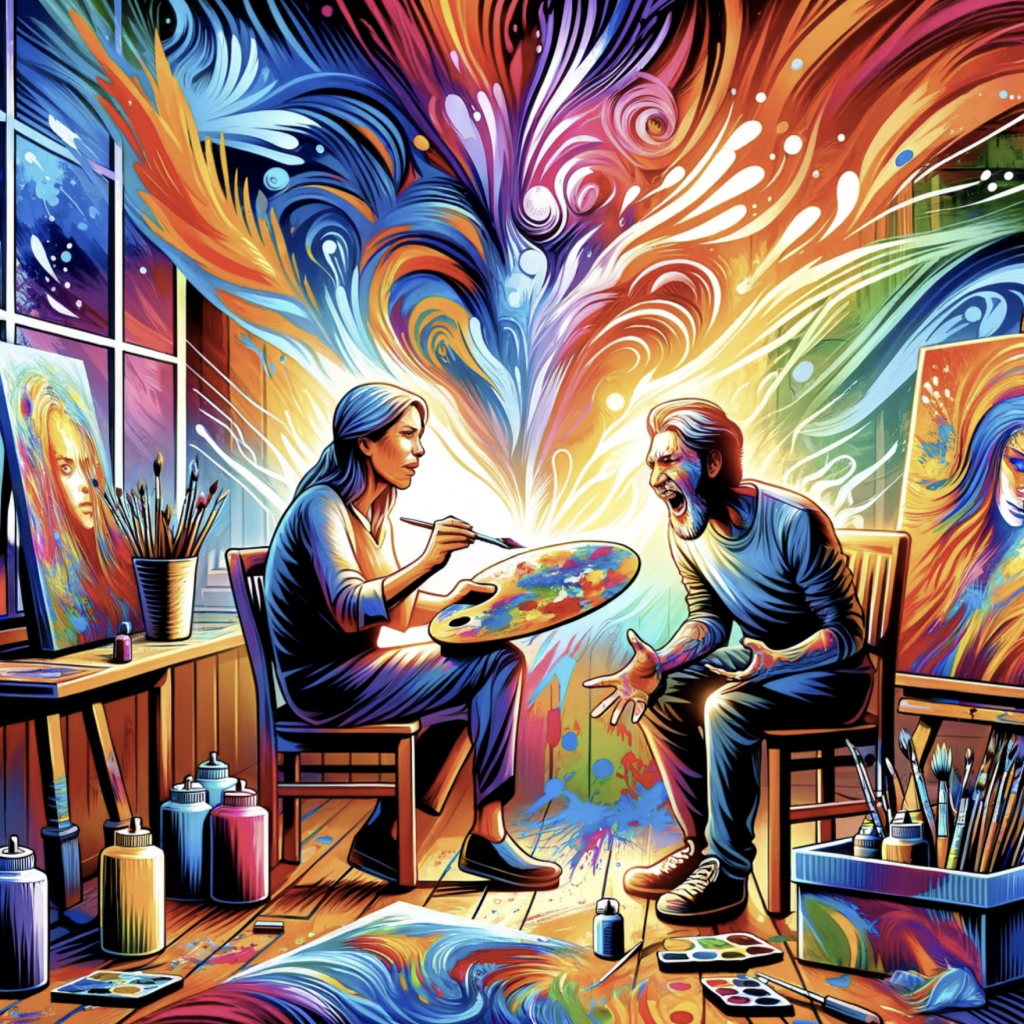
Art therapy, a form of psychotherapy that utilizes artistic activities to improve mental health and emotional well-being, has garnered significant attention in recent years. This therapeutic approach is heralded for its ability to facilitate self-expression and healing, particularly for individuals who find traditional talk therapy challenging. However, the question arises: is art therapy overvalued? This article aims to explore the complexities surrounding art therapy, examining its benefits, popularity, criticisms, costs, and accessibility, as well as the qualifications of therapists and the role of personal stories in understanding its impact.
Understanding Art Therapy
Art therapy is a mental health profession that combines knowledge of psychological theories and art techniques to foster personal development and emotional growth. Its origins can be traced back to the mid-20th century, when psychiatrists and artists began recognizing the therapeutic potential of creative expression. Through activities such as drawing, painting, and sculpture, individuals can explore their feelings, reconcile emotional conflicts, and foster self-awareness. Art therapy is particularly beneficial for those who struggle to articulate their thoughts and emotions verbally, offering a non-verbal outlet for expression.
There are various forms of art therapy, each tailored to meet the unique needs of different individuals. These include visual art therapy, which involves creating images to explore and express feelings, and expressive art therapy, which may incorporate dance, music, and drama. The flexibility and adaptability of art therapy make it a versatile tool for addressing a wide range of psychological issues. Additionally, art therapy can be conducted in individual or group settings, further enhancing its accessibility and applicability.
Art therapy is employed with diverse populations, including children, trauma survivors, and individuals with mental health disorders. For children, art therapy provides a safe space to process experiences and emotions that they may not yet have the language to express. Trauma survivors often find that creating art helps them process and integrate traumatic memories. For those with mental health disorders, art therapy can serve as a complementary treatment, aiding in the management of symptoms and improving overall well-being.
Benefits of Art Therapy
The benefits of art therapy are manifold, extending beyond emotional and psychological well-being. Engaging in creative activities has been shown to reduce stress, enhance cognitive functioning, and improve mood. Art therapy provides a safe and structured environment where individuals can explore their thoughts and feelings without judgment. This process can lead to increased self-awareness, better emotional regulation, and improved interpersonal skills.
Case studies and anecdotal evidence often highlight the transformative effects of art therapy. For example, individuals with post-traumatic stress disorder (PTSD) have reported significant reductions in symptoms after engaging in art therapy. Similarly, children with behavioral issues have shown improvements in social skills and emotional regulation. These stories, while compelling, are often subjective and may not be representative of all individuals who undergo art therapy.
Scientific research supporting art therapy is growing, with studies indicating positive outcomes for various mental health conditions. Research has demonstrated that art therapy can effectively reduce symptoms of anxiety, depression, and PTSD. Moreover, it has been found to enhance cognitive abilities and improve overall quality of life. However, the evidence is still evolving, and more rigorous studies are needed to establish the efficacy of art therapy conclusively.
Despite its benefits, it is essential to compare art therapy with other forms of therapy. Traditional therapies, such as cognitive-behavioral therapy (CBT), have a robust evidence base and are widely regarded as effective treatments for many mental health conditions. Art therapy, while beneficial, may not be suitable for everyone and should be considered as a complementary approach rather than a replacement for traditional therapies.
The Popularity and Perception of Art Therapy
In recent years, art therapy has seen a significant rise in popularity. This can be attributed to an increasing awareness of mental health issues and a growing interest in holistic and alternative therapies. Media portrayal of art therapy often highlights its transformative and healing properties, contributing to its appeal. Art therapy is frequently featured in films, television shows, and news articles, painting a picture of a powerful and accessible therapeutic tool.
Public perception of art therapy is generally positive, with many viewing it as a gentle and non-invasive form of treatment. Testimonials from art therapists and clients often emphasize the profound impact of art therapy on their lives. These personal stories, while valuable, can sometimes create unrealistic expectations about the outcomes of art therapy. It is crucial to approach these narratives with a balanced perspective, recognizing both the potential and the limitations of art therapy.
Art therapy is practiced in various settings, including hospitals, schools, and private practices. In hospitals, art therapy is often used to support patients coping with chronic illness, pain, or trauma. In schools, it can help children navigate emotional and behavioral challenges. Private practice art therapists offer individualized sessions tailored to the unique needs of their clients. The widespread adoption of art therapy across different environments underscores its versatility and broad appeal.
While the popularity of art therapy is a testament to its perceived value, it also raises questions about its efficacy and the evidence supporting its use. As more people turn to art therapy, it is essential to critically evaluate the research and ensure that it is grounded in scientific rigor. This will help to prevent the overvaluation of art therapy and ensure that individuals receive the most appropriate and effective treatment for their needs.
Criticisms and Limitations of Art Therapy
Despite the positive aspects of art therapy, it is not without its criticisms and limitations. One major concern is the lack of standardized practices and certification issues. Unlike traditional therapies, which have well-established protocols and guidelines, art therapy practices can vary widely. This lack of standardization can lead to inconsistencies in treatment and outcomes, making it difficult to assess the true efficacy of art therapy.
Another criticism is the limited scientific evidence supporting art therapy. While there are studies that highlight its benefits, the body of research is still relatively small and often lacks the rigor of studies conducted on traditional therapies. Many studies on art therapy rely on small sample sizes and subjective measures, which can limit their generalizability. More robust, large-scale studies are needed to provide conclusive evidence of art therapy’s effectiveness.
The potential for misuse or overgeneralization of benefits is also a concern. Art therapy may be promoted as a cure-all for various psychological issues, leading individuals to have unrealistic expectations. This can be particularly problematic when art therapy is used as a standalone treatment without adequate support from other therapeutic modalities. It is essential to recognize that art therapy, like any other form of therapy, has its limitations and may not be suitable for everyone.
Comparing art therapy with traditional therapies highlights some of these limitations. Cognitive-behavioral therapy (CBT), for example, has a strong evidence base and is widely recognized as an effective treatment for many mental health conditions. While art therapy can complement traditional therapies, it should not be viewed as a replacement. Instead, it should be integrated into a comprehensive treatment plan tailored to the individual’s needs.
Cost and Accessibility of Art Therapy
The financial costs associated with art therapy can be a significant barrier for many individuals. Art therapy sessions can be expensive, particularly when conducted by certified art therapists with advanced training and experience. Additionally, the materials and supplies needed for art therapy can add to the overall cost. This financial burden can limit access to art therapy, especially for individuals from low-income backgrounds.
Availability of art therapy services varies by region, with some areas having more resources and trained professionals than others. In urban centers, art therapy may be more readily available, while rural areas may have limited access to these services. This disparity can create inequities in who can benefit from art therapy, highlighting the need for greater availability and accessibility of art therapy services across different regions.
Insurance coverage for art therapy is another critical issue. Many insurance plans do not cover art therapy, making it an out-of-pocket expense for many individuals. This lack of coverage can further limit access to art therapy, particularly for those who cannot afford to pay for these services on their own. Advocating for insurance coverage and greater recognition of art therapy as a legitimate therapeutic modality is essential to improving accessibility.
For marginalized or low-income populations, accessing art therapy can be particularly challenging. These individuals may face multiple barriers, including financial constraints, lack of availability, and limited awareness of art therapy as an option. Efforts to increase awareness, reduce costs, and provide accessible services are crucial to ensuring that art therapy is available to all who can benefit from it.
The Role of the Therapist in Art Therapy
The qualifications and training of art therapists play a crucial role in the effectiveness of art therapy. Art therapists typically hold a master’s degree in art therapy or a related field and undergo specialized training in both art techniques and psychological theories. This training equips them with the skills needed to guide clients through the therapeutic process and to use art as a tool for healing and self-discovery.
The therapist-client relationship is fundamental to the success of art therapy. A strong, trusting relationship allows clients to feel safe and supported, fostering an environment where they can explore their emotions and experiences through art. Art therapists must be adept at building rapport and creating a therapeutic space that encourages self-expression and healing.
Ethical considerations are also paramount in art therapy practice. Art therapists must adhere to ethical guidelines that prioritize the well-being and confidentiality of their clients. This includes obtaining informed consent, maintaining boundaries, and ensuring that the client’s art and personal information are treated with respect and confidentiality. Ethical practice is essential to building trust and ensuring that clients feel safe and supported in their therapeutic journey.
The role of the therapist in art therapy extends beyond guiding clients through artistic activities. Art therapists must also be skilled in interpreting the symbolic and metaphorical content of clients’ art, helping them gain insights into their thoughts and feelings. This interpretive work requires a deep understanding of both art and psychology, highlighting the unique expertise that art therapists bring to their practice.
Personal Stories and Case Studies
Personal stories and case studies provide valuable insights into the impact of art therapy. Success stories from art therapy participants often highlight the transformative power of creative expression. For example, a trauma survivor may find that creating art helps them process and integrate their experiences, leading to a reduction in symptoms and an improved sense of well-being. These stories offer a glimpse into the potential of art therapy to facilitate healing and personal growth.
Challenges faced by individuals undergoing art therapy are also important to consider. Not every client experiences significant benefits, and some may find the process challenging or uncomfortable. Understanding these challenges can provide a more balanced perspective on art therapy and help identify areas where additional support or alternative approaches may be needed.
Diverse experiences and outcomes in art therapy underscore the importance of individualized treatment. Each client brings their unique background, experiences, and needs to the therapeutic process, and art therapy must be tailored to meet these individual requirements. This diversity highlights the flexibility and adaptability of art therapy, as well as the need for therapists to be attuned to the specific needs of each client.
Personal stories and case studies also serve to humanize the practice of art therapy. They provide a narrative context that can make the abstract concepts of therapy more relatable and understandable. By sharing these stories, art therapists and clients can help demystify the therapeutic process and encourage others to explore art therapy as a potential avenue for healing and self-discovery.
Alternative Perspectives and Holistic Approaches
Integrating art therapy with other therapeutic methods can enhance its effectiveness and provide a more holistic approach to treatment. Multimodal therapy approaches, which combine different forms of therapy, can address a wider range of needs and provide more comprehensive support. For example, combining art therapy with cognitive-behavioral therapy (CBT) can help clients explore their emotions through art while also addressing cognitive patterns that contribute to their mental health issues.
Holistic and integrative health practices recognize the interconnectedness of mind, body, and spirit. Art therapy can be a valuable component of a holistic approach to mental health, complementing other modalities such as mindfulness, meditation, and physical exercise. This integrative perspective can enhance the overall effectiveness of treatment and support clients in achieving a more balanced and harmonious state of well-being.
Alternative perspectives on art therapy also highlight the importance of cultural sensitivity and inclusivity. Art therapists must be attuned to the cultural backgrounds and preferences of their clients, recognizing that art and creative expression can vary widely across different cultures. Incorporating culturally relevant art forms and practices can enhance the therapeutic experience and ensure that clients feel respected and understood.
Exploring alternative perspectives and holistic approaches to art therapy can also foster innovation and creativity in the field. By remaining open to new ideas and integrating diverse therapeutic methods, art therapists can continue to evolve their practice and better meet the needs of their clients. This ongoing exploration and adaptation are essential to ensuring that art therapy remains a relevant and effective tool for mental health and well-being.
Conclusion
In conclusion, art therapy offers a unique and valuable approach to mental health treatment, providing a non-verbal outlet for self-expression and healing. While it has many benefits, including emotional regulation, increased self-awareness, and improved interpersonal skills, it is essential to approach art therapy with a balanced perspective. The popularity and positive perception of art therapy are supported by personal stories and anecdotal evidence, but more rigorous scientific research is needed to establish its efficacy conclusively.
Criticisms and limitations of art therapy, such as the lack of standardized practices and limited scientific evidence, highlight the need for ongoing evaluation and improvement. Ensuring accessibility and affordability of art therapy services is crucial to making this therapeutic approach available to all who can benefit from it. The role of the therapist and the importance of ethical practice are fundamental to the success of art therapy, emphasizing the need for qualified and well-trained professionals.
Personal stories and case studies provide valuable insights into the impact of art therapy, underscoring its potential to facilitate healing and personal growth. Integrating art therapy with other therapeutic methods and adopting a holistic approach can enhance its effectiveness and provide more comprehensive support for clients. As the field of art therapy continues to evolve, it is essential to remain open to new ideas and perspectives, ensuring that this unique form of therapy remains a valuable tool for mental health and well-being.




